

Mammals. Carnivora. Carnivorans apparently evolved in North America out of members of the family Miacidae (miacids) about 42 million years ago.

They soon split into cat-like and dog-like forms (Feliformia and Caniformia). Arctoidea. Arctoidea is an infraorder of extinct and extant mostly carnivorous mammals which include the extinct group Hemicyonidae (dog-bears), and extant groups Musteloidea (weasels), Pinnipedia (seals, sea lions), and Ursidae (bears), found in all continents from the Eocene, 46 million years ago ago, to the present.[1] Taxonomy[edit] Arctoidea was named by Flower (1869).
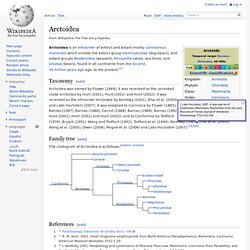
Category:Immediate step-children/Pinnipedimorpha. Pinniped. The meat, blubber and fur coats of pinnipeds have traditionally been used by indigenous peoples of the Arctic, and seals have been depicted in various cultures worldwide.
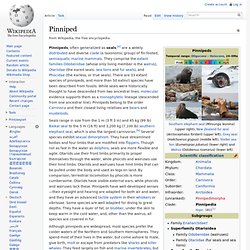
They are commonly kept in captivity and are even sometimes trained to perform tricks and tasks. Once relentlessly hunted by commercial industries for their products, seals are now protected by international law. Feliformia. Feliformia (also Feloidea) is a suborder within the order Carnivora consisting of "cat-like" carnivorans, including cats (large and small), hyenas, mongooses, civets, and related taxa.

Feliformia stands in contrast to the other suborder of Carnivora, Caniformia ("dog-like" carnivorans). Both suborders share one characteristic which distinguishes Carnivora from all other mammals: the possession of the four carnassial teeth. Caniformia. The center of diversification for Caniformia is North America and Northern Eurasia with these regions having the most diversity of Caniforms.
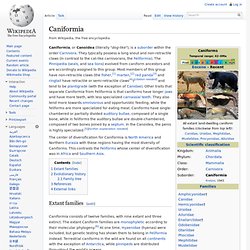
This contrasts the Feliforms whose center of diversification was in Africa and Southern Asia. Extant families[edit] Caniformia consists of twelve families, with nine extant and three extinct. The extant Caniform families are monophyletic according to their molecular phylogeny.[6] At one time, Hyaenidae (hyenas) were included, but genetic testing has shown them to belong in Feliformia instead. Musteloidea. The Musteloidea consists of the families Ailuridae (red pandas), Mustelidae (mustelids: weasels, otters, martens, and badgers), Procyonidae (procyonids: raccoons, coatis, kinkajous, olingos, olinguitos, ringtails and cacomistles), and Mephitidae (skunks).
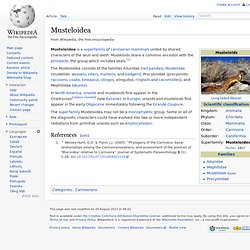
In North America, ursoids and musteloids first appear in the Chadronian[citation needed] (late Eocene). In Europe, ursoids and musteloids first appear in the early Oligocene immediately following the Grande Coupure. The superfamily Musteloidea may not be a monophyletic group. Some or all of the diagnostic characters could have evolved into two or more independent radiations from primitive ursoids such as Amphicynodon. Jump up ^ Welsey-Hunt, G.D. & Flynn, J.J. (2005).
Primate. A primate ( With the exception of humans, which inhabit every continent,[a] most primates live in tropical or subtropical regions of the Americas, Africa and Asia.[5] They range in size from Madame Berthe's mouse lemur, which weighs only 30 g (1 oz), to the eastern lowland gorilla, weighing over 200 kg (440 lb).
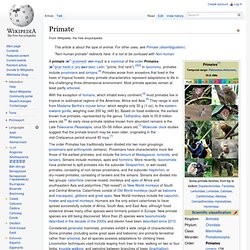
Based on fossil evidence, the earliest known true primates, represented by the genus Teilhardina, date to 55.8 million years old.[6] An early close primate relative known from abundant remains is the Late Paleocene Plesiadapis, circa 55–58 million years old.[7] Molecular clock studies suggest that the primate branch may be even older, originating in the mid-Cretaceous period around 85 mya.[7] Considered generalist mammals, primates exhibit a wide range of characteristics. Some primates (including some great apes and baboons) are primarily terrestrial rather than arboreal, but all species possess adaptations for climbing trees.
Strepsirrhini. Lemuriformes. Lemuriform primates are characterized by a toothcomb, a specialized set of teeth in the front, lower part of the mouth mostly used for combing fur during grooming.
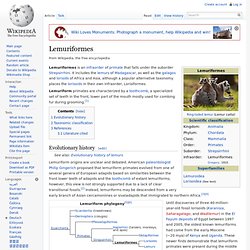
Evolutionary history[edit] Lemuriform origins are unclear and debated. Lemur. Lemurs ( Lemur research focused on taxonomy and specimen collection during the 18th and 19th centuries.

Although field observations trickled in from early explorers, modern studies of lemur ecology and behavior did not begin in earnest until the 1950s and 1960s. Initially hindered by political instability and turmoil on Madagascar during the mid-1970s, field studies resumed in the 1980s and have greatly increased our understanding of these primates. Research facilities like the Duke Lemur Center have provided research opportunities under more controlled settings. Lemurs are important for research because their mix of primitive characteristics and traits shared with anthropoid primates can yield insights on primate and human evolution. Etymology[edit] Haplorhini. The haplorhines, the "dry-nosed" primates (the Greek name means "simple-nosed"), are members of the clade Haplorhini: the tarsiers and the anthropoids.

The anthropoids are the catarrhines (Old World monkeys and apes, including humans) and the platyrrhines (New World monkeys). The omomyids are an extinct group of prosimians, believed to be more closely related to the tarsiers than to any strepsirrhines, and are considered the most primitive haplorhines. Haplorhines share a number of derived features that distinguish them from the strepsirrhine "wet-nosed" primates (whose Greek name means "curved nose"), the other suborder of primates from which they parted in evolution some 63 million years ago.
All anthropoids have a single-chambered uterus; tarsiers have a bicornate uterus like the strepsirrhines. Most species typically have single births, although twins and triplets are common for marmosets and tamarins. Etymology[edit] Simian. The simians (infraorder Simiiformes, Anthropoidea) are the "higher primates" familiar to most people: the Old World monkeys and apes, including humans, (together being the catarrhines), and the New World monkeys or platyrrhines.
Classification and evolution[edit] In earlier classification, New World monkeys, Old World monkeys, apes, and humans—collectively known as simians or anthropoids—were grouped under Anthropoidea (/an'thro-poy'de-a/, Gr. άνθρωπος, anthropos, human), while the strepsirrhines and tarsiers were grouped under the suborder "Prosimii". Primatology, paleoanthropology, and other related fields are split on their usage of the synonymous infraorder names, Simiiformes and Anthropoidea. The simians are split into three groups. Catarrhini. Catarrhini is one of the two subdivisions of the higher primates (the other being the New World monkeys or platyrrhines). It contains the Old World monkeys and the apes; the latter of which are in turn further divided into the lesser apes or gibbons and the great apes, consisting of the orangutans, gorillas, chimpanzees, bonobos, and humans. They are all native to Africa and Asia.
Members of this parvorder are called catarrhines. Description[edit] Ape. Apes (Hominoidea) are a branch of Old World tailless anthropoid catarrhine primates native to Africa and Southeast Asia and distinguished by a wide degree of freedom at the shoulder joint indicating the influence of brachiation. Diprotodontia. Characteristics[edit] Living diprotodonts are almost all herbivores, as were most of those that are now extinct. A few insectivorous and omnivorous diprotodonts are known, but these seem to have arisen as relatively recent adaptations from the mainstream herbivorous lifestyle.
The extinct thylacoleonids ("marsupial lions") are the only known group to have exhibited carnivory on a large scale. Diprotodonts are restricted to Australasia. The earliest known fossils date to the late Oligocene, but their genesis certainly lies earlier than this, as large gaps occur in Australia's fossil record, with virtually no fossil record at all in geologically active New Guinea. Many of the largest and least athletic diprotodonts (along with a wide range of other Australian megafauna) became extinct when humans first arrived in Australia about 50,000 years ago.
Two key anatomical features, in combination, identify Diprotodontia. Fossil record[edit] Classification[edit] Possum. A possum (plural form: possums) is any of about 70 small to medium-sized arboreal marsupial species native to Australia, New Guinea, and Sulawesi (and introduced to New Zealand and China). Possums are quadrupedal diprotodont marsupials with long thick tails. Petauroidea. Petauroidea is a superfamily of marsupials from Australia and New Guinea. Lagomorpha. Taxonomy and evolutionary history[edit] Rodent. Hystricomorpha. The term Hystricomorpha (from Latin hystrix "porcupine" and Greek μορφή, morphē "form")[1] has had many definitions throughout its history.
In the broadest sense, it refers to any rodent (except dipodoids) with a hystricomorphous zygomasseteric system. Hystricognathi. Caviomorpha. Caviomorpha is the rodent infraorder or parvorder that unites all South American hystricognaths. It is supported by both fossil and molecular evidence. The Caviomorpha was for a time considered to be a separate order outside the Rodentia, but is now accepted as a genuine part of the rodents. Cetacea. Fossil evidence suggestst that the cetaceans share a common ancestor with land-dwelling mammals that began living in marine environments around 50 million years ago. Today, they are the mammals best adapted to aquatic life.
Balaenoidea - definition of Balaenoidea by The Free Dictionary. Baleen whale. Sirenia. "Sea cow" (seekoei) is also the name for a hippopotamus in Afrikaans. Birds. Apodiformes. Charadriiformes. Lari. Pan-Alcidae. Gruiformes. Category:Sphenisciformes. Actinopterygii. Perciformes. Gobioidei. Tetraodontiformes. Arachnids. Opiliones. Eupnoi. Spider. Opisthothelae. Araneomorphae. Entelegynae.